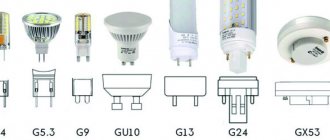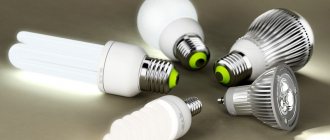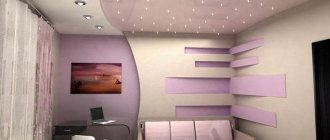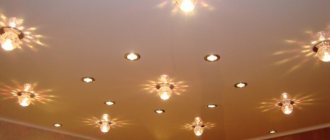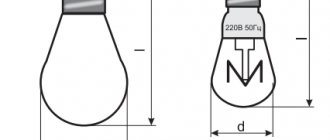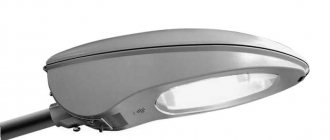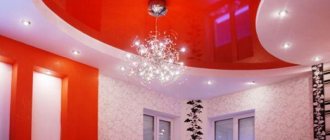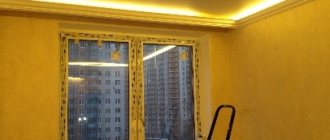Ceiling structures of suspended and tension type are equipped with various types of lighting fixtures. Most often these are spotlights - small-sized spotlights of low power, located in a certain order. By distributing them over the area of the ceiling and walls, directing beams of light or scattering them, designers zone the space.
As a result, per square meter of room there are sometimes 1-2 light sources that require scheduled maintenance or replacement in case of failure. It is difficult to complete this task without knowledge of electrical engineering and the design of a specific model, but it is possible. A plasterboard ceiling, although fragile, can still be manipulated by a non-specialist with a minimum of damage to the structure, while a tension fabric does not forgive mistakes, and in the event of a puncture or cut it can burst along the way. The situation is complicated by differences in the design of fastening systems used by different companies, so it is necessary to consider the features of the main types and models.
Replacing a lamp in a suspended ceiling
Mounting the lamp behind the ceiling.
Ceiling spots mounted flush with the tension fabric are mounted on a special platform attached to the supporting structure. The soffit body is held in place by two springs that press the lamp to the platform.
Spot design.
The load on the stretch ceiling fabric is minimal. To strengthen the fabric, protective and thermal insulating rings are glued along the edge of the hole, but even with them, an attempt to remove the lamp may end in tearing the thin fabric. To avoid damage, the following procedure should be followed when replacing spots:
- De-energize the lighting circuit.
- Using a flat-head screwdriver, carefully pry up the side of the lamp and pull it down with your hands, tilting it in one direction.
- Pull one edge and, holding one of the spacer springs with your finger, pull out first one spring and then the other.
In this case, you need to make sure that the springs do not fall into the gap between the platform and the fabric, since in this case an attempt to remove the device may end in tearing the fabric.
- If the lamp is equipped with LED backlighting or the lamp operates through a transformer, then the power supply will be pulled out along with the wires.
- Having disconnected the wires from the terminal block with a screwdriver, you need to place the stripped conductors of the new lamp into the connectors and tighten the bolts on the terminal block.
Or clamp the plastic clamp if you are using a Vago terminal block.
Connection via Vago terminal block.
The power supply from the contour lighting is connected in parallel with the main light bulb to a 220 V network.
- After connecting the conductors from the socket to the electrical network, the lamp is installed in place. To do this, both springs need to be pressed up and, holding them with one hand, tuck the wires with the power supply or transformer into the space on the platform. The springs are wound behind the mortgage body and released.
Retracting the locking springs.
In this case, you need to make sure that the springs do not straighten out under the mortgage, otherwise the lamp will hang on the suspended ceiling. The fabric also sags if the transformer falls from the mounting platform onto the fabric. This may appear later when, under the weight of the device, the polyvinyl chloride bends at the point of greatest pressure. In this case, the body of the spot must be removed, all elements of the circuit must be re-laid on the platform and the soffit must be placed on the seat in the same order.
Tools and accessories
The variety of lamps leads to the need to know exactly when you can simply replace a light bulb, and when replacing it requires disassembling the lamp. In this case, you will need some tools and accessories:
- stepladder or strong table;
- indicator screwdriver with LED or tester;
- pliers for removing retaining rings;
- flat screwdrivers 2 pcs.;
- Phillips screwdriver;
- construction knife;
- terminal block.
Various types of switching terminals.
Attention: in many works you can find a recommendation to have insulating tape to insulate twisted wires. In our opinion, it is better to refrain from this type of connection - due to poor contact, the wiring may heat up and ignite. A simple terminal, which costs several times less than electrical tape, will quickly and reliably connect the wires.
How to change light bulbs in a suspended ceiling
Plasterboard structures are more rigid, but it is better to avoid frequent manipulations with lighting fixtures, since the plaster in the area of the hole crumbles over time. The basic principles for dismantling and installing spotlights on plasterboard ceilings are the same as on suspended ceilings. Differences in execution techniques concern only the design of the soffit and the light source.
LED
LED elements are gradually replacing lamps of previous generations due to their efficiency, but they have a significant drawback: cheap devices have a flicker coefficient of more than 15%, which is noticeable when shooting video. The eyes become very tired from such light, and vision deteriorates over time. In this regard, it is better not to save money when choosing models for lighting residential and work spaces. The design of LED light bulbs implies the presence of a driver in the housing, so the devices operate directly from a 220 V network, and the lighting circuit does not require additional stabilizers and rectifiers. When changing an LED light bulb, simply remove it in a manner specific to the type of specific base and install a new one in its place.
Halogen
With high energy consumption and a short resource of 5000-10,000 hours, this source has optimal characteristics for vision. The glow of halogen lamps lies in a comfortable range of 3000-4000 K. In addition, their flicker coefficient is most often less than 5%, but only if high-frequency transformers and voltage stabilizers are used. In some cases, halogen failure is associated with failure of the rectifier. Therefore, if after replacing the light bulb the lamp does not work, you need to check the functionality of the remaining elements of the lighting circuit.
Luminescent
Gas-discharge light sources are rarely used for spot lighting, since their compactness is associated with low power. The principle of their operation implies the presence of a ballast in the lighting circuit, which, as a rule, starts a group of several fluorescent light bulbs at once. There are samples with built-in electronic ballasts, but its dimensions increase the distance between the main and suspended ceilings.
Most often, these lamps have an E14 screw base, so replacing them is not difficult.
Useful tips
In the process of dismantling soffits and removing a chandelier, specialists often encounter various difficulties, which can be completely avoided if you familiarize yourself with the following recommendations:
- If incandescent light bulbs were initially installed in the spotlight, then they should be replaced with LED lamps - this will significantly save money on room lighting.
- If you are installing halogen light bulbs, remember that they should never be touched with bare hands, otherwise they will stop lighting.
- If the retaining ring does not fit into the groove, you need to check the correct placement of the lamp; perhaps it is not fully seated. The body of the lamp could also be deformed - it needs to be removed and the unevenness removed or the hole in the hanging structure made larger.
- If you install a new soffit in place of the old one, make a hole with a small margin relative to its diameter - this will significantly simplify dismantling next time.
Rice. 10. Choosing the diameter for the soffit
- If you need to change the chandelier to a spotlight, you can use its output, but you will have to remove the hanging hook. Bend it is extremely dangerous, as it can damage the drywall or film.
- Before removing the spotlight, it is advisable to remove excess glass beads, decorative caps and rings - this will preserve the integrity of fragile parts.
Rice. 11. Soffits with bugles
- After removing the retaining ring, the lamp will fall out of the soffit, so you should also hold it with your hands.
How to change a light bulb in spotlights
For studio and designer lighting, spotlights are used that are attached to the surface of the ceiling or walls directly through the canvas to the platform or by means of a mounting rod.
Fastening to the guide rail.
The peculiarity of the spots is the ability to adjust the direction of the light spot by turning the lamp body on a hinge. The light bulbs in such devices are held by fastening in the socket, and for their removal there is a special vacuum applicator, which is a suction cup.
Dismantling with a vacuum applicator.
The replacement process is quite simple:
- The circuit is de-energized.
- A suction cup is pressed against the plane of the light bulb.
- Depending on the type of base, the applicator pulls toward itself (for GU5.3) or turns counterclockwise 15-20 degrees and extends (for G10).
- The new light source is installed in the reverse order. If the base is pin, type GU5.3 or G9, then the light bulb is simply inserted until it locks. If the base is screw-type, it must be screwed in until it stops (for E14) or clicks, like in G10 or GX53.
If the applicator is not available, you can get the lamp by covering it with tape, as in the photo.
Step by step removal using masking tape.
Possible mistakes
Before replacing the lamp, you need to turn off the electricity in the apartment.
The most common mistakes during installation and dismantling include:
- Replacement with power on. This mistake should not be made; it can lead to serious injury.
- Trying to change the lamp immediately after turning off the light. Even LED sources can get a little warm, so you need to wait until they cool down.
- Selecting a radiator with an unsuitable base.
- Touching a halogen lamp with bare hands. There will be traces of grease on the source, which may cause the flask to crack.
- Using higher wattage light bulbs. This problem is especially relevant for halogen lamps. The GU5.3 base does not make good contact with lamps above 40 W, so it is better to use fluorescent or LED sources. It is not recommended to install lamps with a power higher than 35 W on suspended ceilings.
It is important to pay attention to the choice of lamp. You should carefully inspect the device for defects and check the strength of its parts. It is not recommended to buy cheap LED sources from unknown manufacturers
Such products can quickly fail, do not meet the declared characteristics, and have flickering. It is better to purchase a lighting device from well-known companies
It is not recommended to buy cheap LED sources from unknown manufacturers. Such products can quickly fail, do not meet the declared characteristics, and have flickering. It is better to purchase a lighting device from well-known companies.
Selection of a new light source
The easiest way is to replace the halogen with an LED with the same type of base. To do this, it is enough to remove the transformer from the circuit, since the LED operates directly from a 220 W network. The situation is more complicated when, instead of a two-inch MR16, you have to install a GU53 tablet with a wider diameter. To do this, you need to glue a new tread ring around the small old one onto the tension fabric and trim off the excess fabric. If a universal mortgage is installed on the main ceiling, then it is enough to cut a new hole along the line on the platform with a stationery knife.
Trimming the lampshade to the required size.
In the case of homemade platforms, you will most likely have to remove the canvas, since cutting out a new seat without damaging the fabric of the stretch ceiling will be difficult.
Homemade plywood mortgage.
In some cases, you can install overhead spots or a chandelier on a homemade mortgage.
Types of socles
Regardless of what type of lighting device is used to illuminate the room: energy-saving, halogen, LED, incandescent, you need to decide on the type of mounting. When choosing, the design of the lamp is taken into account. In order to figure out how to change a light bulb in spotlights, you need to learn about the types of bases.
What is a base? This is the part of the light bulb that is used to mount the structure in the socket. In addition, it serves to conduct electricity. Without a base, the lamp will not work. Despite this, baseless devices are sometimes used. They are designed to conduct light in automotive applications.
The design of the base is simple: the body is made of metal or ceramics. Inside are the elements of the light bulb, outside are the contacts for connection.
Each type is marked with letters and numbers. The letter means type, the number means characteristic.
Screw
The most common type for apartments is a screw base. Marked with the letter "E". This is the oldest type of light source mounting. Invented by Edison. The original name is “Edison Screw Type”, or Edison screw type. Hence the letter "E". The number indicates the outer diameter.
Among all Edison sockets, the most common is E27. Lighting fixtures with a diameter of 27 are the most popular in Russian apartments because it is easy to find a light bulb for them. E27 is equipped with traditional incandescent lamps, but has recently been found in halogen, fluorescent and LED lamps.
E14 is also found on the market. They call him "minion". This type is most often found in sconces, table lamps, but sometimes also in suspended and suspended ceilings. Less commonly used are “E” with diameters of 5, 10, 12, 26, and so on.
The main advantages are the prevalence and ease of fastening. There are no shortcomings observed.
Shtyrevoy
This type of base does not use a screw, but a pin connection system. The numbers indicate the distance between the centers of the pins. Used in halogen and energy-saving lamps. Denoted by the letter "G".
The G4 connection is used in small halogen light bulbs. Most often used for decoration, in spotlights, as well as in built-in lamps. There is a G9 type. Used in 220 V AC power supply, suitable for decorative lamps.
For office lighting use tubular G5. For compact lighting fixtures, there are sockets with four pins (2G10, 2G11). There are many such lamps. In order not to get confused when buying a new light bulb, it is recommended to take with you an old, burnt-out light source.
In addition to the types described above, there is the “GU” type. This means that the lamp is energy saving. The most common for suspended ceilings is GU5.3. Their thickness is 2.7 centimeters.
Bayonet
This type of connection is also called bayonet or pin. The source is installed in the lighting fixture by inserting and scrolling. Widely used for various purposes, most often in suspended, stretch ceilings and cars. The device operates in the presence of strong vibration.
This type of connection between a lighting fixture and a light source is often used in transport and more. For example, in the UK this is a standard connector.
Bayonet fasteners are usually designated by the letter “B”, and the number that comes after the letter indicates the outer diameter of the connector.
There are bases with different numbers of contacts (from 1 to 5). They are also designated by the letter:
- “s” - single contact;
- "d" - double;
- “t” - three contacts;
- "q" - four;
- "p" - five.
In everyday life, as a rule, lamps with one and two contacts are used. The rest are in production.
What do you need to know about safety when fixing to the ceiling?
Here experts give several important recommendations:
LEDs get very hot
Therefore, special radiators are used for cooling. Contact and heat dissipation are improved thanks to special thermal paste at the junction between two important elements. When installing, it is important to ensure that there is free space around the radiators, not enclosed. Otherwise, the LEDs will fail prematurely.
It is also prohibited to install lamps near heating appliances. Special regulators and light bulbs with a dimming function will be needed for those who are interested in adjusting the level of brightness and lighting. Availability of replacement lamps is an important factor when choosing suitable models.
Where can you hang an LED light?
Stretch and suspended ceiling structures – these are the products with which LED spotlights are most often used. Devices can be located in the center or on the sides. Here, each buyer chooses the option that best meets current operating conditions.
Types of lighting fixtures
The modern market for lighting devices offers a large number of types of light bulbs, among which the most famous and widespread are:
- Incandescent lamps are an outdated type and cannot be used for suspended ceilings due to the surface temperature being too high. In addition, this type consumes a large amount of electricity and has a short service life;
Light bulb with filament Source stroy-podskazka.ru
- Luminescent - popular “housekeepers”, so named because of their modest electricity consumption, give a good luminous flux, practically do not heat up during operation, but at the same time they flicker and pose a health hazard due to the mercury content in the bulb;
Housekeeper type light bulbs Source elektrik-a.su
- Halogen lamps are an improved analogue of classic light bulbs, in which gas is added to increase the brightness of the lighting. The products are sold at reasonable prices and have an increased shelf life, while their disadvantages are largely the same as sources with filament;
Halogen light bulb Source strojdvor.ru
- Based on LEDs - the most economical and safe type, characterized by a long service life and good light characteristics. Such devices do not flicker and do not pose a threat to the environment. The only drawback of the devices is their high cost, although recently there has been a gradual decrease in cost.
Light bulb based on LEDs Source ledosvet.com
